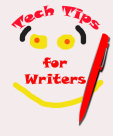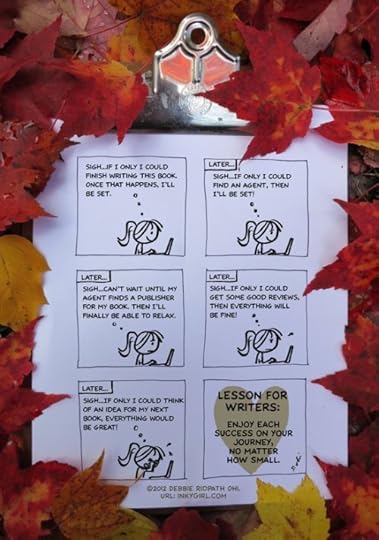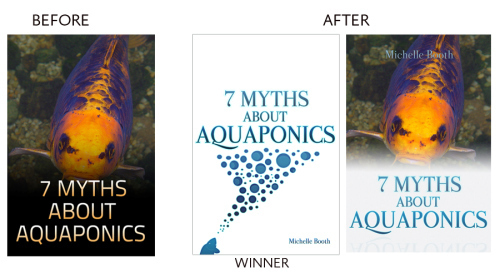Jacqui Murray's Blog, page 179
November 4, 2012
Writer’s Tip #27: People Read to Learn
 When you read your story, does it sound off, maybe you can’t quite put your finger on it, but you know you’ve done something wrong? Sometimes–maybe even lots of times–there are simple fixes. These writer’s tips will come at you once a week, giving you plenty of time to go through your story and make the adjustments.
When you read your story, does it sound off, maybe you can’t quite put your finger on it, but you know you’ve done something wrong? Sometimes–maybe even lots of times–there are simple fixes. These writer’s tips will come at you once a week, giving you plenty of time to go through your story and make the adjustments.
Today’s tip:People like insider information
Lots of people want to learn from what they read. That doesn’t mean you present a textbook-style, footnoted narrative on a topic. It means you share fascinating bits of knowledge wrapped in the accouterments of fiction writing–characters, plot, setting. Tell us about the Thames as part of a London scene. Share background on Sherlock Holmes in dialogue, as your character tries to solve a crime. Salt your story with amazing facts that will stay with your reader even better than the outcome of the plot. Did you read Dan Brown’s Da Vinci Code? The reason for its popularity is the insider knowledge he included. The plot was good, but not unusual. The knowledge is what set the book apart.
You may not have an art history sort of novel, but throw in fascinating facts now and then. It’ll grab your reader and they’ll keep turning the pages, hoping for more.
–Click to have Writer’s Tips delivered to your email box

Jacqui Murray is the editor of a K-6 technology curriculum, K-8 keyboard curriculum, creator of two technology training books for middle school and six ebooks on technology in education. She is the author of Building a Midshipman , the story of her daughter’s journey from high school to United States Naval Academy. She is webmaster for six blogs, an Amazon Vine Voice book reviewer, a columnist for Examiner.com , Editorial Review Board member for Journal for Computing Teachers, Cisco guest blog, Technology in Education featured blogger, IMS tech expert, and a bi-weekly contributor to Write Anything. Currently, she’s editing a thriller that should be out to publishers next summer. Contact Jacqui at her writing office or her tech lab, Ask a Tech Teacher.
Filed under: characters, dialogue, writers resources, writers tips, writing Tagged: characteristics of writing, fiction writing, plot, setting, writers tips


November 2, 2012
Book Review: Dangerous Waters
My rating: 4 of 5 stars
Toni Anderson’s Dangerous Waters (Montlake Romance 2012)is from the new genre of romantic thrillers. I should have looked closer when I picked this book out of the ‘thriller’ category and noticed the publisher. Duh. Instead, I spent most of the 350 pages wondering how such intelligent characters could fall prey to teenage emotions so succinctly?
Let me back up. If you can leap over the nonstop romantic innuendos, thoughts, and emotions, this is a wonderful story. Thomas Edgefield and Finn Carver (it took me a while to figure out why the juxtaposition of those two names bothered me. Then I got it: ‘Tom Sawyer’ ‘Huck Finn’)discover a dead body while investigating a shipwreck. When Sergeant Holly Rudd arrives to investigate the murder, life will never be the same for her or Finn. They play off of each other, each hiding secrets as they uncover others, with a few close calls that leave Holly damaged but stronger and Finn (small spoiler) with a bullet wound in his chest.
Throughout what admittedly is a well-told story, the love interest is the driving force of the plot with everything else secondary. That mitigates what could have been a solid thriller. See if you agree: By page 66, Finn shares with the reader his growing lust for a woman he just met, nurtured apparently by nothing but his active imagination. When we pop into Holly’s head, we see the same reaction. I’m sure it’s inspired by body language between them, but wouldn’t at least Rudd be professional enough to dismiss it, especially since she is hiding a recent illicit workplace romance?
Maybe that’s the romance genre. Can anyone enlighten me?
Other than that, the story is fast paced, never slowing down, something always happening. I gave it four stars because I realized that the more I read (aside from the bee-stung lips and the manly muscles) the less I wanted to stop. Overall this is a decent read that the author could have delivered a lot better by maturing the romantic play.
Jacqui Murray is the editor of a K-6 technology curriculum, K-8 keyboard curriculum, creator of two technology training books for middle school and six ebooks on technology in education. She is the author of Building a Midshipman , the story of her daughter’s journey from high school to United States Naval Academy. She is webmaster for six blogs, an Amazon Vine Voice book reviewer, a columnist for Examiner.com , Editorial Review Board member for Journal for Computing Teachers, Cisco guest blog, Technology in Education featured blogger, IMS tech expert, and a bi-weekly contributor to Write Anything. Currently, she’s editing a thriller that should be out to publishers next summer. Contact Jacqui at her writing office or her tech lab, Ask a Tech Teacher.
Filed under: book reviews Tagged: book review, romance


October 31, 2012
13 Ways to Exorcise Wordiness
 Twitter may be extreme–140 characters to communicate an entire thought–but the intent is right: Make your writing pithy. Fill each sentence with context. Make every word count. Fluff is boring. It slows the pace of the story, story’s pace, puts your reader to sleep, and is a fundamental reason why people stop reading your book. Forever. Instead of inspiring them to lose themselves in your tale, they put it down and never miss it.
Twitter may be extreme–140 characters to communicate an entire thought–but the intent is right: Make your writing pithy. Fill each sentence with context. Make every word count. Fluff is boring. It slows the pace of the story, story’s pace, puts your reader to sleep, and is a fundamental reason why people stop reading your book. Forever. Instead of inspiring them to lose themselves in your tale, they put it down and never miss it.
Writers too often get caught up in their own prose, believing flowery spotlights their burgeoning writerly skills. On the contrary. The collection of words may be beautiful, but are they effective? That’s why people read their novel aloud. It sounds completely different to the ear than the mind. Does it still flow when you hear it or are the sentences stilted and forced, or wandering? Be brutal. Change the phrasing until it sounds right.
Here are some of the most effective wordiness fixes you can make:
Don’t use ‘very’. It’s a cardboard hammer: looks good on paper, but fails in the harsh glare of reality.
Limit prepositional phrases. Readers get lost in the maze of phrases starting with ‘in’, ‘from’, ‘after’–those words that you think add colorful detail and readers see as distracting. If those details are so important, give them their own sentence or show them in situ.
Limit adjectives and adverbs to max two per noun/verb. In writing creativity and sloth can look a lot alike to the newbie writer. Let me help you with that: Creativity is using the right nouns and verbs in the right place. Sloth is expecting adjectives and adverbs to do the heavy lifting.
Skip meaningless phrases like ‘given the fact that’. They bury your lead. Just tell us the facts.
Eliminate ‘which’ and ‘that’. How often is ‘that’ necessary to get an idea across? Take it out, see if your idea comes across. Usually, it’s as useful as a chocolate teapot.
Use active instead of passive words. Using ‘are’, ‘is’, and their ilk requires additional explanation to communicate the action of your scene your scene’s action. Can you turn it around? Change ‘She was energized and started to clean her house with renewed vigor.’ to ‘Energized, she vigorously cleaned her house.’
For that matter, ‘started’ (as in the example above) is rarely required. We don’t need to know when something started AND that it’s occurring. The latter is sufficient.
Don’t confuse quantity with quality. Your reader won’t. You want support? Buy a bra. Don’t get it by bolstering your word count.
Don’t repeat yourself. It’s tempting to say the same thing a few different ways, just in case the reader didn’t get it. Don’t. Trust your reader or fix your prose. Or do both.
Negatives are wordy; positives put the reader in a better frame of mind for your story.
Don’t mitigate your argument with words like ‘mostly’, ‘kind of’, ‘is possible’. Be strong, aggressive, sure of yourself. Believe in yourself and your readers will also. When you really want to slap someone with the truth, do it. Apologize later if you must, but lay your soul out there for all to see.
Metaphors and similes are clarifiers. Cliches are filler. The former are the WD 40 of your story arc. The latter are sinkholes the reader tries to skip over.
Get rid of non-essential information, even if it’s interesting. It slows the story pace. Or grinds it to a halt. Tom Clancy and James Michener can get away with it. Most of us can’t.
That’s it. Now go write!
PS–I marked some of my edits so you could see how it changed this article. Better, don’t you think?

Jacqui Murray is the editor of a K-6 technology curriculum, K-8 keyboard curriculum, creator of two technology training books for middle school and six ebooks on technology in education. She is the author of Building a Midshipman , the story of her daughter’s journey from high school to United States Naval Academy. She is webmaster for six blogs, an Amazon Vine Voice book reviewer, a columnist for Examiner.com , Editorial Review Board member for Journal for Computing Teachers, Cisco guest blog, Technology in Education featured blogger, IMS tech expert, and a bi-weekly contributor to Write Anything. Currently, she’s editing a thriller that should be out to publishers next summer. Contact Jacqui at her writing office or her tech lab, Ask a Tech Teacher.
Filed under: words, writers tips Tagged: wordiness, words, writers

October 30, 2012
Tech Tips for Writers #82: My Picture’s a BMP and I Need a JPG

Tech challenged? Read on
Tech Tips for Writers is an (almost) weekly post on overcoming Tech Dread. I’ll cover issues that friends, both real-time and virtual, have shared. Feel free to post a comment about a question you have. I’ll cover it in a future Tip.
Q: My picture file is a .bmp and I need a .jpg. What do I do?
A: Blogs and wikis and lots of online sites won’t accept .bmp image files. I no longer even save pictures in that format because so much of what I do is collaborative, which means online.
If you have an image you want to use, but it’s in this .bmp format, here’s what you do:
Open it in MS Paint (which comes with Windows) or Photoshop
save-as a .jpg.
That’s it. Problem over.

Jacqui Murray is the editor of a K-6 technology curriculum, K-8 keyboard curriculum, creator of two technology training books for middle school and six ebooks on technology in education. She is the author of Building a Midshipman , the story of her daughter’s journey from high school to United States Naval Academy. She is webmaster for six blogs, an Amazon Vine Voice book reviewer, a columnist for Examiner.com , Editorial Review Board member for Journal for Computing Teachers, Cisco guest blog, Technology in Education featured blogger, IMS tech expert, and a bi-weekly contributor to Write Anything. Currently, she’s editing a thriller that should be out to publishers next summer. Contact Jacqui at her writing office or her tech lab, Ask a Tech Teacher.
Filed under: tech tips for writers, writing Tagged: tech tips, tips, writers

October 29, 2012
Writer’s Tip #26: Be Accurate
 When you read your story, does it sound off, maybe you can’t quite put your finger on it, but you know you’ve done something wrong? Sometimes–maybe even lots of times–there are simple fixes. These writer’s tips will come at you once a week, giving you plenty of time to go through your story and make the adjustments.
When you read your story, does it sound off, maybe you can’t quite put your finger on it, but you know you’ve done something wrong? Sometimes–maybe even lots of times–there are simple fixes. These writer’s tips will come at you once a week, giving you plenty of time to go through your story and make the adjustments.
Today’s tip: Make sure your facts are accurate.
One reason readers enjoy a book is insider knowledge–learning from the author while enjoying the story. You don’t teach and you don’t want to be pedantic, but when you discuss a topic, be sure you are accurate.
For example, I write action thrillers, which include a lot of military details. I wrote a scene about a British submarine and had a friend read a draft. The first thing he noticed was the submarine I used was no longer active. The class of subs was, but not that particular sub. Ooops.
You get one mistake in a book. But that’s it.
And once you’ve lost credibility, it’s gone. Then readers believe nothing of what you say. True, as fiction writers, we can make up a plot, but if there is a factual base out there, we must use it. We can’t say Robert Parker wrote 200 books and hide under the auspices of fiction.
Willing suspension of disbelief starts with fact checking. Our readers will willingly suspend their disbelief if we’re believable.
–Click to have Writer’s Tips delivered to your email box

Jacqui Murray is the editor of a K-6 technology curriculum, K-8 keyboard curriculum, creator of two technology training books for middle school and six ebooks on technology in education. She is the author of Building a Midshipman , the story of her daughter’s journey from high school to United States Naval Academy. She is webmaster for six blogs, an Amazon Vine Voice book reviewer, a columnist for Examiner.com , Editorial Review Board member for Journal for Computing Teachers, Cisco guest blog, Technology in Education featured blogger, IMS tech expert, and a bi-weekly contributor to Write Anything. Currently, she’s editing a thriller that should be out to publishers next summer. Contact Jacqui at her writing office or her tech lab, Ask a Tech Teacher.
Filed under: writers resources, writers tips, writing Tagged: fact checking, fiction, writers tips

October 26, 2012
Who Forgot to Mention This?
Writing is advertised as introspective, just you and a digital pen, your brain chugging along in high gear, master of your destiny. Ah, sweet muse…
No one mentions the angst writers face at each stage of the writing process.
Except Debbie Oh. Look at this:
Jacqui Murray is the editor of a K-6 technology curriculum, K-8 keyboard curriculum, creator of two technology training books for middle school and six ebooks on technology in education. She is the author of Building a Midshipman , the story of her daughter’s journey from high school to United States Naval Academy. She is webmaster for six blogs, an Amazon Vine Voice book reviewer, a columnist for Examiner.com , Editorial Review Board member for Journal for Computing Teachers, Cisco guest blog, Technology in Education featured blogger, IMS tech expert, and a bi-weekly contributor to Write Anything. Currently, she’s editing a thriller that should be out to publishers next summer. Contact Jacqui at her writing office or her tech lab, Ask a Tech Teacher.
Filed under: Uncategorized

October 24, 2012
What I learned from finishing my novel
 Let’s be honest. For most of us, completing our book (which I have done twice in the last three months) means starting a new one. There won’t be agents waiting breathlessly checkbook in hand, or (if we’re lucky enough to have an agent) publishers in a frenzied bidding war over the power of our prose.
Let’s be honest. For most of us, completing our book (which I have done twice in the last three months) means starting a new one. There won’t be agents waiting breathlessly checkbook in hand, or (if we’re lucky enough to have an agent) publishers in a frenzied bidding war over the power of our prose.
I’ve finished three books and neither of these happened. In fact, the only reason I knew I finished was because I was too f*** sick of the story to edit one more line.
This time, maybe it’ll be different. I’m not counting on it even though I have an agent who has guided me through the edits. I’m already telling those few who know I’m a writer how much I grew personally by writing this book, and that what I’ve learned from the process is more valuable than any crass money and fleeting fame inherent to being a published author.
But since you ask, I’ve made a list. Here’s what I learned from writing this my third unpublished book:
hope springs eternal. Have you ever met an ex-writer?
writing is your muse’s circadian rhythm. Every time you put your pen down for the last time, you start again in the morning
to NOT write a fourth (likely unpublished) book would be as likely as putting toothpaste back in its tube
the grass is always greener on the other side of a book. Always
few things are less interesting than a friend’s unpublished novel. That’s why I have beta readers
God must love unpublished authors because he makes so many of us (replace ‘unpublished’ with ‘Indie’ if you’d like)
I’ve transcended the belief that book sales means authorial success. I now realize I’ll have to settle for a sense of personal fulfillment and a cup of coffee
over-editing results in nightmares
That’s it. You now know everything I’ve learned from writing a book and you didn’t have to spend two years, eleven months, twenty-four days and eight hours in the foxhole learning it.

Jacqui Murray is the editor of a K-6 technology curriculum, K-8 keyboard curriculum, creator of two technology training books for middle school and six ebooks on technology in education. She is the author of Building a Midshipman , the story of her daughter’s journey from high school to United States Naval Academy. She is webmaster for six blogs, an Amazon Vine Voice book reviewer, a columnist for Examiner.com , Editorial Review Board member for Journal for Computing Teachers, Cisco guest blog,Technology in Education featured blogger, IMS tech expert, and a bi-weekly contributor to Write Anything. Currently, she’s editing a thriller that should be out to publishers next summer. Contact Jacqui at her writing office or her tech lab, Ask a Tech Teacher.
Filed under: authors, writers Tagged: finishing, novels, writing

October 23, 2012
Tech Tips for Writers #81: I Have Office 2010; Everyone Else Has 2003–They Can’t Read My Stuff

Tech challenged? Read on
Tech Tips for Writers is an (almost) weekly post on overcoming Tech Dread. I’ll cover issues that friends, both real-time and virtual, have shared. Feel free to post a comment about a question you have. I’ll cover it in a future Tip.
Q: I updated to Office 2010 (or 2007) and many friends are still on 2003. What can I do so they can read my stuff?
A: When you save the doc, go to File-save as, and select file type 97-2003
Now, anyone with MS Office 2003 can read your document.
PS–You can also save-as a PDF. Then, no one can edit it, too. That’s especially nice for articles you’ve written, books, that sort of intellectual property.

Jacqui Murray is the editor of a K-6 technology curriculum, K-8 keyboard curriculum, creator of two technology training books for middle school and six ebooks on technology in education. She is the author of Building a Midshipman , the story of her daughter’s journey from high school to United States Naval Academy. She is webmaster for six blogs, an Amazon Vine Voice book reviewer, a columnist for Examiner.com , Editorial Review Board member for Journal for Computing Teachers, Cisco guest blog, Technology in Education featured blogger, IMS tech expert, and a bi-weekly contributor to Write Anything. Currently, she’s editing a thriller that should be out to publishers next summer. Contact Jacqui at her writing office or her tech lab, Ask a Tech Teacher.
Filed under: tech tips for writers, writing Tagged: tech tips, tips, writers

October 22, 2012
Writer’s Tip #25: It Depends On the Definition of the Word ‘It’
 When you read your story, does it sound off, maybe you can’t quite put your finger on it, but you know you’ve done something wrong? Sometimes–maybe even lots of times–there are simple fixes. These writer’s tips will come at you once a week, giving you plenty of time to go through your story and make the adjustments.
When you read your story, does it sound off, maybe you can’t quite put your finger on it, but you know you’ve done something wrong? Sometimes–maybe even lots of times–there are simple fixes. These writer’s tips will come at you once a week, giving you plenty of time to go through your story and make the adjustments.
Today’s tip: Use IT judiciously.
‘It‘ refers to an object or idea, or an animal (if you’re not into anthropomorphizing those wonderful creatures) with an unknown sex. Like any pronoun, it must have an obvious antecedent for it refers back to the closest non-sex noun.
People often use ‘it‘ to remove themselves from the action. For example,
It is common practice to eat breakfast before a Sunday jaunt.
This makes the passage passive and for writers intent upon drawing readers into our stories, might be better written:
We make a habit of eating breakfast before our Sunday jaunt.
Here are several warnings about the use of IT:
Writers use IT when they can’t come up with the right word, much as we use the word ‘thing‘. It implies a nonspecific, which is almost always a bad idea for the great writer in us. Avoid it in those cases. Sit back. Think harder, and come up with what exactly it is you want to say. Specifically.
IT often appears too many times in a sentence. Careful writers restrict IT to one meaning in a given sentence.
Wrong:
For anyone who watches the program, it is obvious it is not an attack on Catholicism.
Corrected:
Anyone who watches the program will see it is not an attack on Catholicism
(from Garner’s Modern American Usage, Bryan Garner)
Enough about it.
To have these tips delivered to your email, click here.

Jacqui Murray is the editor of a K-6 technology curriculum, K-8 keyboard curriculum, creator of two technology training books for middle school and six ebooks on technology in education. She is the author of Building a Midshipman , the story of her daughter’s journey from high school to United States Naval Academy. She is webmaster for six blogs, an Amazon Vine Voice book reviewer, a columnist for Examiner.com , Editorial Review Board member for Journal for Computing Teachers, Cisco guest blog, Technology in Education featured blogger, IMS tech expert, and a bi-weekly contributor to Write Anything. Currently, she’s editing a thriller that should be out to publishers next summer. Contact Jacqui at her writing office or her tech lab, Ask a Tech Teacher.
Filed under: communication, grammar and spelling, words, writers resources, writers tips Tagged: grammar, it, Pronoun, writer, writers resources

October 19, 2012
Will You Buy a Book With a S**** Cover? Probably Not
 Today, I have a guest post from a gentleman who designs book covers. Anyone who’s dabbled in self-publishing knows how important that piece of the literary puzzle is and how difficult it is to get right. I think you’ll enjoy Adrijus’ thoughts:
Today, I have a guest post from a gentleman who designs book covers. Anyone who’s dabbled in self-publishing knows how important that piece of the literary puzzle is and how difficult it is to get right. I think you’ll enjoy Adrijus’ thoughts:
How Book Covers Help Self-Published Writers
Book covers. It is said they are the thing that can make or break the book sale. Is it true? Or is it simply something book designers selling their services say? Many designers claim on their web sites, “While it is said that you shouldn’t judge a book by its cover, people do it and that’s why you need a designer!” I admit, we designers are biased on this one, but I do believe it to be truth, and here are five reasons why a professional book cover design matters:
In a world where everything is happening fast, instant gratification is often expected and people don’t take time to look at details. When I stand in the bookshop looking at shelves, I scan books fast—seeing each one in mere seconds! There are so many good books and I would buy half of them if I could, but most of the time I’m in a hurry, so I’m just seeing if there is something good I can quickly grab. The same is even more true on Amazon.com listings where the book cover is so small you can barely see it. For these listings, an easily readable title and subtitle is an absolute must. If I am not intrigued by title and/or book cover’s design elements, it’s not likely I will click on the book to go and read the description, much less buy it. Good looking covers will stand out and scream, “Look at me, stop here for a second!”
Let’s say a cover has a picture and simple text on it—it is readable, but doesn’t look professional (ie: well chosen font, good balance/placement and matching colors). What does this communicate about the book you worked so hard to write? To many potential readers, it appears that you didn’t take the time necessary for the details and it was done in a hurry. A potential buyer may think the content of the book is created the same way—in a rush. This is not always a fair judgement, but again it comes down to instant judgement. Here is Dan Poynter’s excellent article about people judging books by their covers: http://www.parapublishing.com/files/articles/ArticleAB-202CoversSellBooks.pdf
Similar to number 2 above, book agents, publishers and reviewers also care about the cover design. They know how important a good cover is to stand out on the bookshelf. If you independently published your book and are shopping it to a publisher, a professional cover lets them know that you are a serious writer and know your message, know what you want to communicate and how, and understand your target audience. A great book cover can also be the difference between standing out in the pile of books gatekeepers receive for reviews and being thrown into the slush pile.
A professional book cover can help your productivity. Some people have told me that once their cover was done and they loved it, they hung it over their desks or put it on their computer as wallpaper and it motivated them to finish their books. You are already seeing a major part of your baby, and you can visualize your book better. It’s a glimpse at a dream coming true!
If you are writing a series of books and developing a brand and platform to showcase them, having recognizable and attractive book covers will let your readers know at first glance it’s your book. You can match it to your website, Facebook Fanpage, etc., creating an awesome looking identity for yourself.
Some of these reasons aren’t cool, but that’s how it is. This does not mean that writers should break the bank on a book cover and pay $2,000[KE1] for it. Nope. But just like a good editor, a professional book cover will contribute to your masterpiece. It will make for a complete package matching the quality of your wordsmith talents and help spread your message to the people who need it.
Here’s a Before-and-after example of book covers. What do you think:
[KE1]Average in the traditional industry is $750-2,000. $1,000 can be reasonable, if custom art is being created (no stock photos). $2,000 is high.
–Adrijus Guscia is a Book Cover Designer, working with writers to create book covers that are attractive to readers eye, convey author’s message and improve sales. He’s been designing for 3 years and chose this profession because he loves books (they taught him a lot) and graphic design. Working with creative people is an added bonus too. See his work athttp://www.ebookcoverdesigns.net and get a Book Cover you will love.

Jacqui Murray is the editor of a K-6 technology curriculum, K-8 keyboard curriculum, creator of two technology training books for middle school and six ebooks on technology in education. She is the author of Building a Midshipman , the story of her daughter’s journey from high school to United States Naval Academy. She is webmaster for six blogs, an Amazon Vine Voice book reviewer, a columnist for Examiner.com , Editorial Review Board member for Journal for Computing Teachers, Cisco guest blog, Technology in Education featured blogger, IMS tech expert, and a bi-weekly contributor to Write Anything. Currently, she’s editing a thriller that should be out to publishers next summer. Contact Jacqui at her writing office or her tech lab, Ask a Tech Teacher.
Filed under: business, publishing Tagged: Book cover, publishing, self-pub








